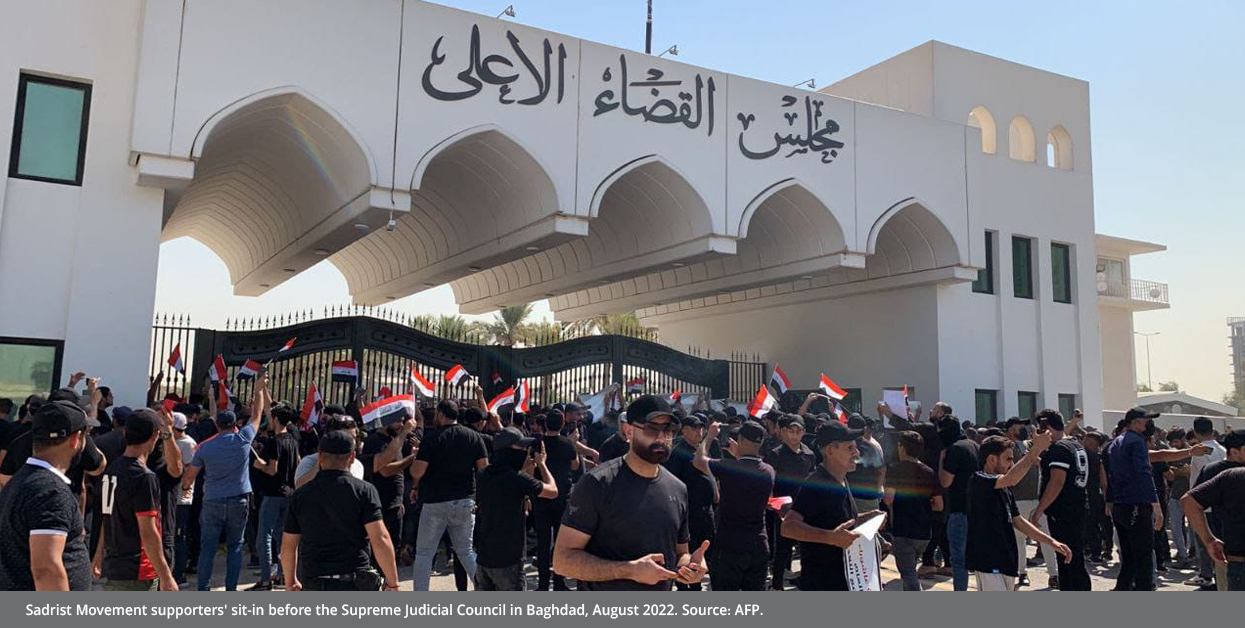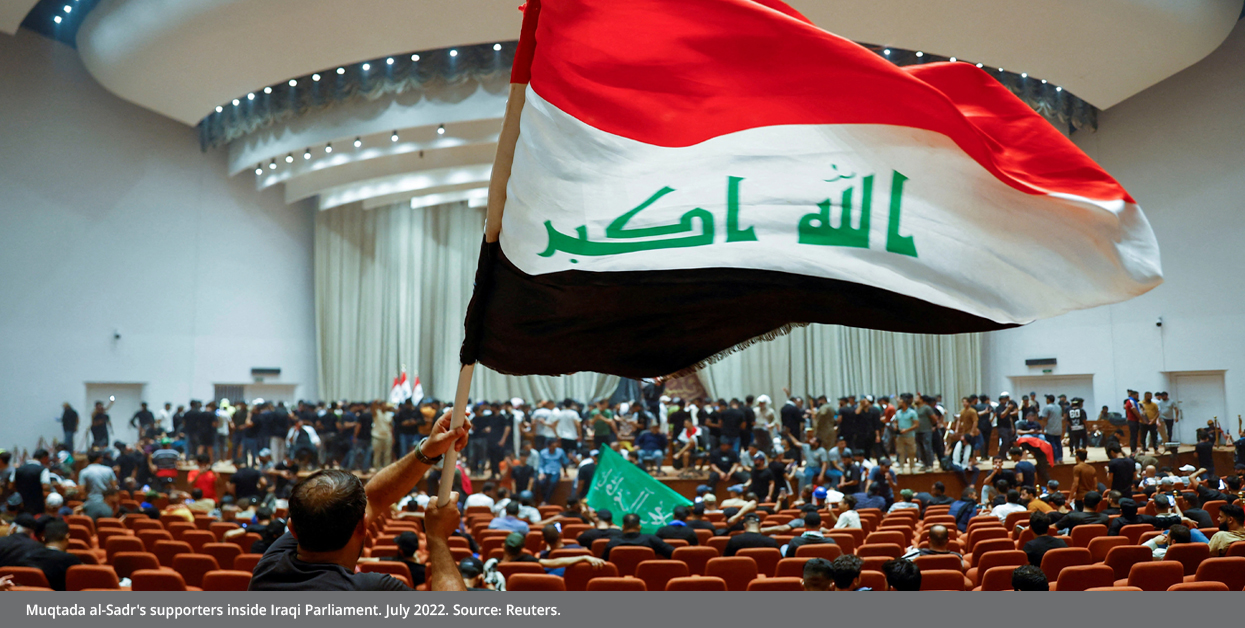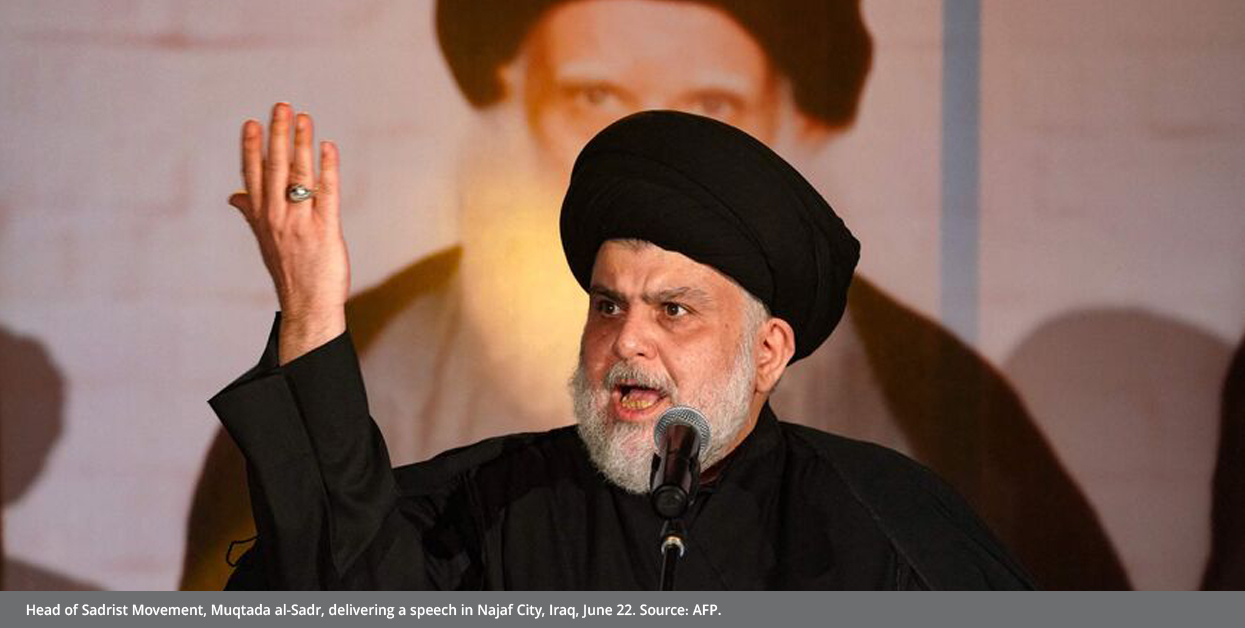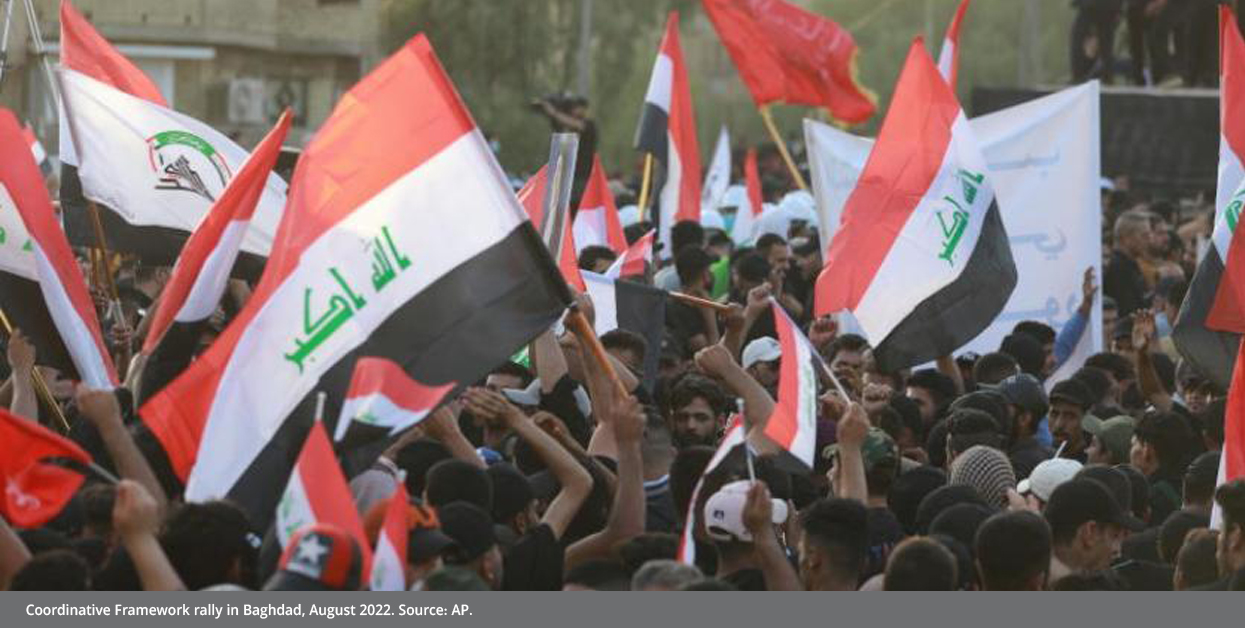Al-Sadr Retirement: Crawling from the Dome to the Palace
Position Assessment| This paper addresses the dimensions and underlying reasons that prompted Iraqi leader Muqtada al-Sadr to retire from the political life. Several stages preceded the decision, starting with the withdrawal of his deputies from parliament, then the sit-in in front of the Supreme Judicial Council, and ending with his supporters storming the Republican Palace after to the announcement of his retirement.
by Dr. Adnan Al-Rubaie
- Release Date – Aug 29, 2022

Shia Muslim leader Muqtada Al-Sadr’s announcement on Monday August 29 to retire permanently from Iraqi politics cannot be interpreted in isolation from the country’s deepening crisis. Al-Sadr’s retirement announcement marked a new shift in a list of changes to the political process in Iraq’that include demonstrations in Baghdad followed by his supporters holding a sit-in in parliament and the Judicial Council.
Today, al-Sadr supporters are heading to the Republican Palace, indicating that the ceiling of demands has reached regime change.
These shifts come in the context of a series of events and transformations punctuated by repeated threats to al-Sadr to retire and leave the decision to the public to either retreat their escalation or revolt. Such transformations came as a response to the successive pressures on al-Sadr. One day earlier, on August 28, the Sadrist religious authority residing in Iran, Kazem al-Haeri, announced his own retirement and, in a veiled message to leave Muqtada al-Sadr, urged Sadrist followers to transfer their loyalties to Iranian Supreme Leader Ali Khamenei.
Al-Sadr’s retirement opens the door wide to a set of new challenges in the political process as it constitutes a call upon his followers to escalate the protests and not be limited to standing before the parliament. In other words, Al-Sadr’s retirement left the decision to the public and, at the same time, embarrassed the parties that wanted to pressure him through multiple practices. But the decision is not up to Al-Sadr. By withdrawing, he stopped all attempts at mediation and initiatives, especially those that were scheduled to be submitted by the president of the Kurdistan Region. Also, the announcement of retirement before the Federal Court session ad hoc in cases to dissolve parliament is considered pressure of another sort.

In this assessment, we consider the dimensions and the underlying reasons that prompted Sadr to retire from political life.
A Threshold of a New Stage
Al-Sadr found himself in a new historical phase, which he has not familiar with since entering political work in 2006, after his path shifted from "military resistance" against the American presence, to a strong presence in successive parliaments and governments. He proved his presence in the political arena, and had popular and mass grassroots, enabling him to face any political threats and allowing him to adopt opposing positions on various political issues.
In addition, al-Sard’s other sources of power, represented by his military wing, starting in 2004 with the Mahdi Army, the al-Yaom al-Mawood (the Promised Day), and Saraya al-Salam (the Peace Brigades) after ISIS took control of Iraqi territory. It is true that the Sadrists have not been accustomed to militarily facing any political rival since they entered politics, but the Sadrists’ possession of an armed wing represents a fear among many political forces. Therefore, the strength of the Sadrist Movement militarily is an obsession for an unexpected act at any moment.
The sources of power possessed by the Sadrists in Iraq led other parties to avoid their uninvolvement (i.e. Sadrists) in political work, even participating in the repeatedly forming governments. This quest was clear when the Sadrists withdrew to participate in the 2021 elections. However, the Shia political blocs rolled over Sadr in order to convince him to enter the elections by providing guarantees to correct the political course. Al-Sadr responded and returned to participate in the elections, winning them and obtaining the largest bloc. But al-Sadr could not pass the majority government that he and his partners called for.
Therefore, he urged his 73 deputies to resign, not retracting his decision despite the repeated attempts to persuade him to reverse it. Thus, the Sadrist Movement’s rival Coordinative Framework—consisting of al-Qanon (the Law), al-Nasr (the Victory), al-Hikma (the Wisdom), Badr, and al-Sadiqoon (the Honest Ones)—went on to choose replacements for Sadr’s deputies and decided to proceed. The formation of the government turned a blind eye to the Sadrist supporters and their potential reaction to forming the government without the Sadrists movement, gaining its entitlements.
As a result, al-Sadr’s supporters entered the parliament after days of anticipating how things would turn out. Al-Sadr tried to send messages that his absence in the process could not be overlooked. Those messages were sent through tweets to his followers that they were ready, followed by a unified prayer through which he sought to present the scale and strength of his supporters. But the opposition party expected that they were empty threats and that Sadr would not be able to escalate further protest to the point of hindering them. So they took the initiative to nominate Mohammed Shia al-Sudani, the head of the Euphrates bloc, which currently holds only one seat in the parliament. Al-Sudani joined the Coordination Framework after the elections, prompting the Sadrists to follow their leader’s calls to demonstrate, storm and sit-in in the Iraqi parliament and government headquarters.
- Events evolved in an accelerated manner, starting with the invitation of Muqtada al-Sadr in the first statement, after his followers entered the parliament, which included a number of points. His demand to change the constitution, reform the judiciary body, and change the form of the political system.
- His call on the Iraqi tribes to support him in the process of change.
- His call for the civilian force and the masses to support him.
These demands represented a shift in the Sadrist discourse, the matter that provoked mixed reactions in the seriousness and possibility, which faced mixed reactions from its partners (the Kurdistan Democratic Party) showing that the change in the constitution needs the approval of different parties and not just one side.
One of the problems with the Sadrist discourse is that it contradicts the accepted protest’s logic, which is based on the gradual progression of the discourse to reach the peak of demands. Sadr’s discourse starts with high demands, then rushes into or retracts the subsequent stages. Indeed, the Sadrists overlooked the logic of comprehensive change and then turned to demand the dissolution of parliament.
The reasons for such retraction
- Al-Sadr did not measure the popular and political response to his protest before making demands.
- There was no international and regional position in support of the demands for change.
- There was not as much public interaction as Sadr expected, as dozens of Tishrenioun joined his protest but did not adopt a unified position on Sadr’s demands.
- Sadr’s Sunni and Kurdish partners have not reacted to calls for change.
- The tribal interaction was not so great, as the tribes were divided between pro-Sadr and those that sided with the Coordinative Framework, while the larger side chose not to intervene.
- The Coordination Framework did not leave the streets to al-Sadr alone. They mobilized their supporters to stand in protest to defend the regime.

All these means made al-Sadr retreat a bit, calling for the dissolution of parliament. But even that call did not succeed. The solution requires holding the parliament sessions or forming an elected government that seeks a solution. Those parties are not currently available.
This prompted al-Sadr to ask the Federal Court to take its role within a deadline of days to dissolve the parliament and call for new elections. The Federal Court noted that it does not have the capacity to dissolve the parliament, as per Article (93) of the Constitution on the Federal Court Authority. The solution, then, remains closed to parties that have parallel supporters since their methods are considered to be contrary to the Constitution.
Accordingly, al-Sadr surprised the political parties with his supporters protesting in front of the Judiciary Authority building without prior official announcement on Tuesday morning, August 23, 2022, demanding the dissolution of Parliament as well as holding the corrupt accountable. But the confrontation of the judiciary body opened doors of condemnation against al-Sadr, starting with the statement of the Supreme Judicial Council, which halted the courts of appeal work all over Iraq in protest against violating the judiciary building. This was followed by a statement of the Coordinative Framework that announced it would not hold a dialogue with the Sadrist movement except by abandoning “the occupation of institutions and sitting on the political table,” which led al-Sadr to call for the protesters to return from the Supreme Judicial Council.
Thus, the protest moves in front of the Council had many indications, including the following:
- The judiciary was not an institution available to Sadrist protest, like the parliament and the government. The statement of the Supreme Judicial Council was firm, as it has not seen it face a force with the Sadrist masses since 2003.
- The Sadrists expanded the circle of their opponents, and the judiciary has become a new element they fight.
- The policy of the Sadrist stages contains mistakes, including going to court.
- The unwillingness to compromise on the Coordinative Framework, as protesting against the judiciary represented an opportunity to pounce and explicitly declare the cessation of dialogue.
- The Sadrists have removed the option of the judiciary as an alternative to taking over if events may develop, according to them, in which the judiciary became part of or party to the crisis.
Adversaries Domain
Al-Sadr lost part of his ability to embarrass his opponents because he had expanded their domain. Having previously directed his protests or opposition in general against a party or against the political and governmental approach in a symbolic manner targeting no group or party, he later presented a clear picture defining his adversaries.
In the current crisis, al-Sadr chose the rivalry against all Shiite forces. Perhaps the result of the elections is what prompted such forces to band together in the face of the Sadrist movement, which holds the most seats in parliament. Al-Sadr parliamentary power can only be confronted by gathering forces to preserve the pillars of their presence and not working under al-Sadr’s leadership or subordination to his previous demand to include blocs such as Hakim, Abadi, and Amiri. However, after al-Sadr’s attempts to annex them fell into despair, everyone came under al-Sadr’s crosshairs.
The expansion of al-Sadr’s adversaries was not limited to the Shiite blocs, as the Sadrist movement’s discourse caused a rift in the existing relationship with their Sunni and Kurdish allies, starting with al-Sadr’s call for a change in the constitution and the political system. This demand is a unilateral decision by al-Sadr, made without consulting his Kurdish and Sunni partners. The Kurds consider the 2005 Iraqi constitution to be one of their achievements that cannot be abandoned within the regime. This is in addition to the Sadrist practices in parliament after the entry of their masses, sending messages to Sunnis who consider the parliament the largest institution that the current regime allocated to them.
Although the statements by both sides were not explicit, they shied away from supporting Sadrist demands, weakening the momentum of support in al-Sadr’s favor.
Lacking a Start Point for a Solution
The political situation and the current crisis, especially within the Shiite parties, lacks a start point for a solution, which was not possible even if the parties invited by al-Sadr to join his alliance had responded. This is because the joining of those parties to al-Sadr or his political rivals means that the crisis is not on the way towards a solution.
The explanation for the development and escalation of the crisis is due to the absence of a middle party capable of reconciling its two parties, the Sadrist Movement and the Coordinative Framework. The previous elections did not face friction between the supporters of the competing parties, especially within the Shiite provinces. The reason is due to the presence of three parties leading the electoral competition, in addition to new forces formed after the protests, including Ishraqa Kannon. The competition was not limited to only two parties but to three : Sadrist Movement, al-Fatah, and the State of Law, Hakim, and Abadi forces state.
The presence of a third party in the competition, the state forces, was part of the dispersal of congestion that may generate friction between the two parties representing the far right or left, the State of Law and al-Fatah, the Sadrist Movement. Although the electoral propaganda of the two parties was based on the competition of the other, the presence of a third party contributed to alleviating that tension.
It was possible that the al-Hikma Movement (Wisdom Movement), along with the al-Nasr Coalition (Victory Alliance) were the middle party that helped ease the crisis, especially since al-Sadr reacted to them after the elections. However, their joining the Coordinative Framework led them to lose the ability to be a party that eases the momentum of skirmishesand, instead, became part of it. Perhaps the results of the 2021 elections and obtaining two parliamentary seats are what pushed them to be a bloc with a party, allowing them to move away from their small representation and preventing them from exercising their role as mediator. This quickly exacerbated the political dispute and events.
Conflict’s Underlying Causes
Despite all the analyses that the causes of the conflict between al-Sadr’s methodology based on the formation of the three parties—democratic, sovereign, and Sadrist bloc—to form a majority government, the hidden structure of the conflict indicates that there are two main reasons for it.
The conflict between the clergyman as a symbol and the warrior
After 2003, there were a number of contexts that enabled the symbolism of the clergy to emerge, becoming the first symbolism in Iraq in line with the parties of political Islam that then took control of the reins and the role of the religious authority in drafting the constitution, as well as thrusting the elections forward. The dedication of a special paragraph to the religious authority in the constitution’s preamble is evidence of the clerics dominance at that stage. Even if al-Sadr raised the slogan of resistance, he still possesses the symbolism of the cleric as a higher symbolism with which his supporters interact, especially after he entered the political work.
Fighting with ISIS in 2014 restored the symbolism of the “warrior” to be a strong competitor to the cleric, rallying around it a number of forces defending that symbolism. The hostile discourses between the two parties are only a representation of that conflict. The Coordinative Framework sees al-Sadr as trying to weaken the new symbolism. But al-Sadr reminds them of the symbolism of the cleric. For example, his request in his unified assembly in al-Sadr City (to repent before the Sistanian reference) is only a reminder that the symbolism of the cleric is the highest. Therefore, the current conflict between two symbolisms, where one is struggling to survive its symbolism while the other wants to grab a new symbolism that will hold the pillars of society.

Popularism and the democratic means
Since the beginning of the crisis, after the results of the 2021 elections between the Coordinative Framework and the Sadrist movement, and the two sides are exchanging insinuations that are ranging from the popular force to democratic means. The Sadrists began to talk about the results of the elections, which is the democracy at which it must be the rule. The Coordinative Framework matched that by the threat with the public, as the upper holder of the right, whose right should not be waived. The vision then turned after the withdrawal of the Sadrists. Al-Sadr threatened with a popular power and called it the owner of legitimacy, mirrored by the Coordinative Framework that sees democracy as represented by what the current parliamentary representation came with.
The truth is that the two opinions do not represent the full truth of either stage; neither elections represent democracy, rather, it is one of its tools, nor does public governance represent legitimacy, for these are phrases that third world countries have derived from true democracy, which believe that once there are elections means that they have achieved democracy. In light of the fact that many non-democratic countries hold periodic elections, does not mean that they have turned into democracy. There are countries, ruled by one party, and hold elections. Elections are an instrument of democracy, that requires a social contract, agreed-upon by all parties without imposing one on the other, so that its results are satisfactory to all.
As for the perception that it is the public who rules, it is an exaggeration that should be considered. Many populists invested, under the pretext that the public rules even during coups and revolutions, in this equation. But it needs a social structure and a democratic culture, not a political democracy based on “legitimate tyranny“ (electoral, populist) whose parties are fighting to obtain that legitimacy, forgetting the infrastructure that guarantees it to be a real democracy. The majority of the public will be the ruler, if it is convinced of the existence of a political opponent and if it is convinced that equality for all is able to use power not to bully and exclude others.
Rules of Engagement
The current crisis shows that there are rules of engagement between the opposing parties. Such rules may be implicit, defined by the common goal between the two parties, which is that any current clash contributes to weakening one or both of them, especially since the parties may have almost equal powers. So one side escalates in the media when the other retreats while working to calm the situation when the other party escalates.
There is evidence that serves as an example of the implicit rules of engagement. The Coordination Framework chose a place for its supports to sit-in away from the Sadrists’ places of protest, with no chance of friction between the two supports. Meanwhile, al-Sadr retracted a million-strong demonstration he had previously announced after the Framework announced a similar demonstration on the same day. Thus, the two sides seek mutual pressure and even weakening each other without clash. They are also looking for a way out of the crisis that suggests victory for each other with the least losses. Therefore, the parties sought to invite the religious authority in Najaf to have a say in the crisis because its opinion represents an embarrassment to all parties in front of their supporters. Its intervention means ending the crisis without much collision.

Conclusion
All the aforementioned indicators indicate that the trajectories of the current crisis may expand to other dimensions, such as civil disobedience, through which al-Sadr will try to put pressure on the Coordinative Framework through the disruption of institutions. In addition, time ranges may be prolonged to prepare al-Sadr for such disobedience in advance of the resignation of his deputies via pushing for the adoption of the Food Security Law, which provided the current government with funds to help it in the event of a prolonged crisis.
However, disobedience will remain within the rules of the engagement’s limits; no one is expected to decide between the two sides. There is even a push for a security confrontation from the government to the demonstrators, as well as pressure that the government become the counter party. That confrontation will transform the conflict, and there will be an armed presence of Sadrist protesters.
It is difficult to expect an end to the confrontation, as al-Sadr may not return. His supporters believe that their return to their homes is a betrayal to al-Sadr. Therefore, it is expected that the number of protesters will increase significantly, perhaps with an influx from the provinces. Only in that case will there be a role for the religious authority, represented by Sayyid Ali al-Sistani, being the remaining link that has not yet been consumed. The fact that al-Sadr’s withdrawal transformed the conflict from two parties between two sides into a conflict of supporters that corresponds to the political system is also a justification for Sistani’s intervention.
The opinions expressed in this study are those of the author. Strategiecs shall bear no responsibility for the views and/or opinion of its author on security, economic, social, and other issues, as they do not necessarily represent the views of the Think Tank.
Dr. Adnan Al-Rubaie
Researcher in Iraqi political affairs
 العربية
العربية